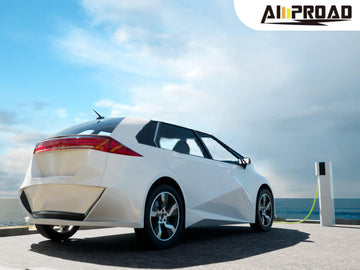
The Electric Vehicle (EV) Tax Credit offers a valuable incentive for those considering an electric car. This program can reduce the overall tax burden for eligible buyers, making EV ownership more affordable. The credit amount depends on factors such as battery capacity and manufacturer eligibility. By taking advantage of this incentive, drivers can enjoy potential savings while contributing to a more sustainable future.
What Is the Electric Car Tax Credit?
The Electric Car Tax Credit reduces federal income tax for qualifying EV buyers, with the amount depending on battery capacity and manufacturer eligibility. The credit phases out once an automaker sells 200,000 eligible EVs, affecting availability. To claim the credit, buyers must file IRS Form 8936 when submitting their tax return, ensuring the vehicle meets federal criteria. As more drivers switch to EVs, investing in a reliable home charging solution like the Amproad Level 2 Home EV Charger enhances convenience and efficiency, making electric driving even more practical.

How the EV Tax Credits Work?
Electric Vehicle (EV) Tax Credits play a crucial role in making electric cars more accessible and financially appealing. These incentives help offset the cost of purchasing an EV, encouraging more drivers to make the switch to sustainable transportation.
When you buy a qualifying EV, you can claim a tax credit that directly reduces your federal income tax bill. The exact amount depends on the vehicle’s battery capacity and the manufacturer. To claim the credit, you must file IRS Form 8936 with your tax return, ensuring your EV meets the eligibility criteria set by the IRS. However, the credit is not a direct rebate—it only offsets your tax liability, meaning it benefits those whose owed taxes are equal to or greater than the credit amount.
A key limitation to be aware of is the phase-out rule: once an automaker sells 200,000 eligible EVs, the tax credit for that brand gradually decreases. Additionally, while new EV purchases have traditionally been the focus, used EV buyers can now also benefit. Starting January 1, 2023, pre-owned EVs at least two years old and priced at $25,000 or less may qualify for a tax credit of up to $4,000 or 30% of the sale price, whichever is lower. However, this credit applies only to dealership purchases and comes with strict income limits—$150,000 for joint filers, $112,500 for heads of households, and $75,000 for single filers.
As EV adoption grows, ensuring a seamless charging experience at home becomes just as important as tax incentives. Investing in a reliable Level 2 EVCS, like the Amproad Home Level 2 Charger, allows EV owners to charge faster and more efficiently, maximizing the benefits of electric driving.

Which Cars Qualify for A EV Tax Credit?
Determining which cars qualify for an Electric Vehicle (EV) Tax Credit can be a dynamic process, subject to frequent updates as new models are added or removed from the list. Currently, several vehicles qualify for either full or partial credits, providing a glimpse into the diverse options available. Here are some of the qualifying models as of now:
|
Vehicle Model |
Qualification Years |
|
BMW X5 xDrive50e |
2024 |
|
Cadillac Lyriq |
2023-2024 |
|
Chevrolet Blazer EV |
2024 |
|
Chevrolet Bolt EV |
2022-2023 |
|
Chevrolet Bolt EUV |
2022-2023 |
|
Chevrolet Equinox EV |
2024 |
|
Chevrolet Silverado EV |
2024 |
|
Chrysler Pacifica PHEV |
2022-2024 |
|
Ford E-Transit |
2022-2023 |
|
Ford Escape PHEV |
2022-2023 |
|
Ford F-150 Lightning |
2022-2023 |
|
Ford Mustang Mach-E |
2022-2023 |
|
Jeep Grand Cherokee 4xe PHEV |
2022-2024 |
|
Jeep Wrangler 4xe PHEV |
2022-2024 |
|
Lincoln Aviator Grand Touring PHEV |
2022-2023 |
|
Lincoln Corsair Grand Touring PHEV |
2022-2023 |
|
Rivian R1S |
2022-2023 |
|
Rivian R1T |
2022-2023 |
|
Tesla Model X |
2022-2023 |
|
Tesla Model 3 |
2022-2023 |
|
Tesla Model Y |
2022-2023 |
|
Volkswagen ID.4 |
2023 |
Given the dynamic nature of this list, it's advisable to check frequently for updates as the electric vehicle landscape evolves. Stay informed about the latest additions and removals to ensure accurate information on vehicles eligible for EV Tax Credits.
How to Claim the Federal EV Tax Credit?

Claiming the federal Electric Vehicle (EV) tax credit is a valuable opportunity for EV buyers, but understanding its details is essential for maximizing its benefits. To apply, taxpayers must submit IRS Form 8936 with their federal tax return. However, since this credit is nonrefundable, it can reduce or eliminate tax liability but won’t generate a direct refund or carry over to future tax years.
A critical aspect of the tax credit is its association with the delivery date rather than the purchase date. If an EV is bought in one year but delivered the next, the credit is applied to the tax return for the delivery year. For instance, an EV purchased in 2023 but received in 2024 would be claimed on the 2024 tax return, filed in 2025.
Looking ahead, changes in 2024 may offer a more immediate way to benefit from the tax credit. A new provision is expected to allow buyers to transfer the credit directly to the dealership, effectively reducing the vehicle's price at the point of sale rather than waiting to claim it on a tax return. While details are still being finalized, this shift could make EV ownership even more accessible.
As policies evolve, staying informed is crucial for making the most of available incentives. The push for greener transportation is gaining momentum, and government incentives play a key role in encouraging widespread adoption. Understanding these tax benefits not only helps with financial planning but also supports the transition to cleaner mobility.
For EV owners, maximizing convenience goes beyond financial incentives. Investing in a reliable charging solution, such as a level 2 portable EV charger, ensures faster and more efficient charging at home or on the go. Combining tax savings with practical charging solutions makes the shift to electric vehicles even more rewarding.
You may be interested in exploring other knowledge about electric vehicles:


